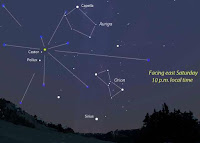Asteroid 2015 SV2 passed by the Earth at a distance of 14 800 000 km (38.5 times
the average distance between the Earth and the Moon, or 9.89% of the
average distance between the Earth and the Sun), at about 3.45 pm
GMT on Saturday 5 December 2015. There was no danger of the asteroid
hitting us, though had it done so it would have presented a considerable
threat. 2015 SV2 has an estimated equivalent diameter of 120-390 m
(i.e. it is estimated that a spherical object with the same volume would
be 120-390 m in diameter), and an object of this size would pass
through the atmosphere and directly impact the ground with a force of
about 50-2500 megatons (roughly 2940 to 147 000 times the explosive
energy of the Hiroshima bomb), causing devastation over a wide area and
creating a crater about 1.5-5.5 kilometers across, and resulting in global climatic problems that could last for decades or even centuries.
The calculated orbit of 2015 SV2. JPL Small Body Database.
2015 SV2 was discovered on 21 September 2015 (75 days before its closest approach to the Earth) by the Defense Advanced Research Projects Agency's Space Surveillance Telescope.
The designation 2015 SV2 implies that it was the 71st asteroid
(asteroid V2) discovered in the second half of September 2015 (period
2015 S).
2015 SV2 has an 1423 day orbital period and an eccentric orbit tilted at
an angle of 6.48° to the plane of the Solar System that takes it from
1.06 AU from the Sun (i.e. 106 % of the average distance at which the
Earth orbits the Sun) to 3.89 AU from the Sun (i.e. 389% of the average
distance at which the Earth orbits the Sun, considerably over twice times the
distance at which the planet Mars orbits). It is therefore classed as an
Amor Group Asteroid (an asteroid which comes close to the Earth, but
which is always outside the Earth's orbit). This means that close
encounters between the asteroid and Earth are fairly common, with the
last thought to have happened in October 1972 and the next predicted in January 2047.
See also...
 Asteroid 2015 WB13 passes the Earth. Asteroid
2015 WB13 passed by the Earth at a distance of 18 950 000 km (49.3 times
the average distance between the Earth and the Moon, or 12.7% of the
average distance between the Earth and the Sun), at about 8.55 pm
GMT on Thursday 3...
Asteroid 2015 WB13 passes the Earth. Asteroid
2015 WB13 passed by the Earth at a distance of 18 950 000 km (49.3 times
the average distance between the Earth and the Moon, or 12.7% of the
average distance between the Earth and the Sun), at about 8.55 pm
GMT on Thursday 3... Geminid Meteor Shower should be clearly visible this year.
The Geminid Meteor Shower is expected to peak on Sunday 13-Monday 14
December this
year (2015) with potentially up to 120 meteors per hour being visible in
areas of the Northern Hemisphere with a clear sky...
Geminid Meteor Shower should be clearly visible this year.
The Geminid Meteor Shower is expected to peak on Sunday 13-Monday 14
December this
year (2015) with potentially up to 120 meteors per hour being visible in
areas of the Northern Hemisphere with a clear sky... Asteroid 2004 XK14 passes the Earth. Asteroid
2004 XK14 passed by the Earth at a distance of 14 720 000 km (38.3 times
the average distance between the Earth and the Moon, or 0.84% of the
average distance between the Earth and the Sun), slightly after 7.40 pm
GMT on Friday 28...
Asteroid 2004 XK14 passes the Earth. Asteroid
2004 XK14 passed by the Earth at a distance of 14 720 000 km (38.3 times
the average distance between the Earth and the Moon, or 0.84% of the
average distance between the Earth and the Sun), slightly after 7.40 pm
GMT on Friday 28...
Follow Sciency Thoughts on Facebook.

